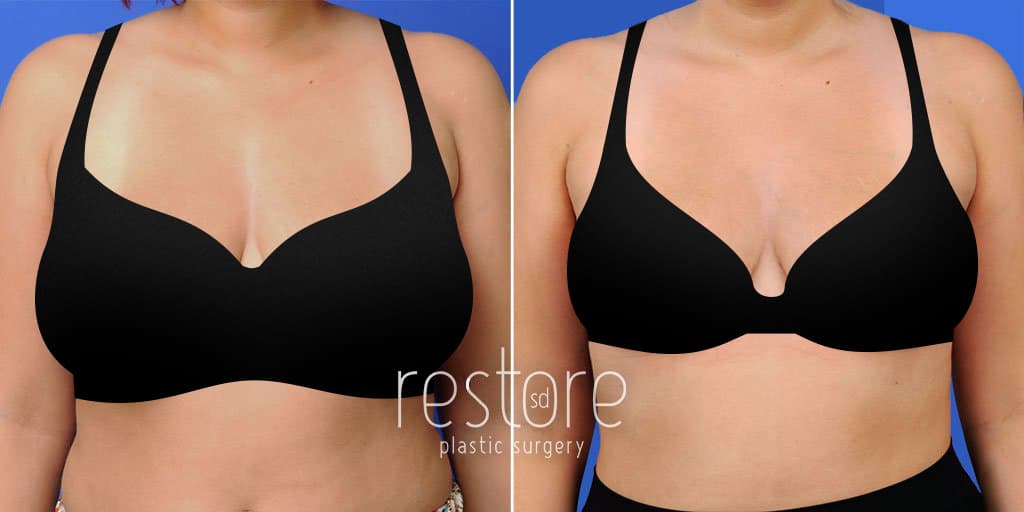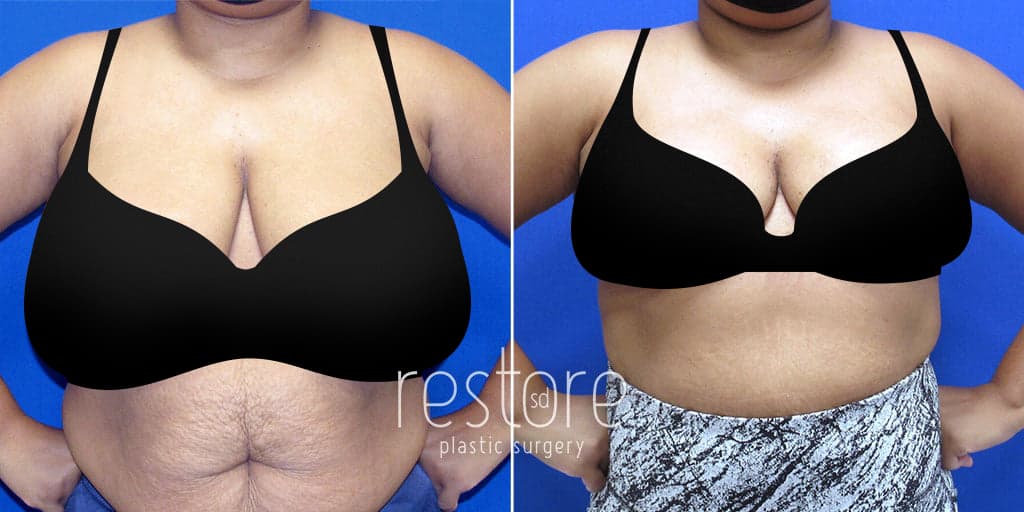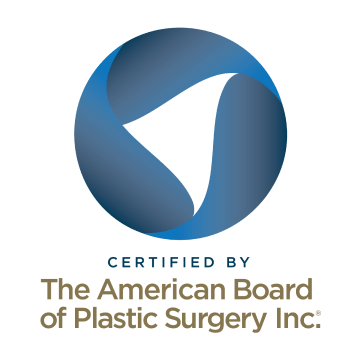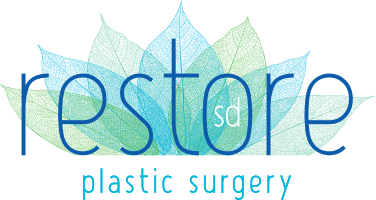Breast Reduction
If you have physical discomfort and other frustrations due to excess weight in your breasts, we understand what you are going through. Back pain, bra strap grooving, chafing—the list goes on! San Diego plastic surgeon Dr. Katerina Gallus has over 20 years of experience helping patients reverse these symptoms, and our breast reduction patients are some of the happiest we see post-op.
What is breast reduction?
Breast reduction is performed to reduce breast size by removing excess tissues, as well as to provide an aesthetic improvement and better quality of life. During breast reductions, Dr. Gallus skillfully reshapes and lifts the breasts into perkier form and repositions the nipples higher on the chest to create a natural-looking result customized for you. This procedure may:
- Reduce back and neck pain caused by heavy breasts
- Minimize skin irritation below the breasts
- Help with your posture
- Create a more proportional size that feels comfortable and allows you to fit more easily in a variety of clothing tailored for women
- Address asymmetrical breast size
Who should get breast reduction surgery?
Patients come to us for a breast reduction procedure at a range of life phases—during their college years, post-baby, or after they’ve become a grandparent—yet all of them are looking for more comfort, confidence, and freedom. You may want more freedom with fashion choices, crave a more active lifestyle, or hope to reduce soreness and pain in your neck, shoulders, and back. Here are some of the concerns women share with us:
- You are self-conscious about your breast size
- Your excessively large breasts are out of proportion with your body frame
- You struggle to shop for clothes that fit and flatter you—and have never found the perfect supportive, comfortable bra
- You have to wear more than one sports bra to exercise
- You have a dent or “bra strap grooving” in your shoulders
- You feel limited in your ability to play sports, dance, or practice yoga
- You have rashes or skin irritation under your breasts
- You have breast ptosis (drooping of the breast)
Whatever your reasons may be, if you are thinking about breast reduction, it’s a great time to sit down with a board-certified plastic surgeon. Dr. Gallus will meet with you in a consultation and answer questions, explain different options like breast lift (where appropriate), and empower you with the information needed to decide: the options that are best for you, the results you can expect, and safety and risks.
Ideal Patients for Breast Reduction
You need to be in good health before breast reduction—and you need to be ready to clear the calendar for surgical downtime! Chances are, now is a good time for you if you agree with the following statements:
- You are in good health
- You are at a stable weight that you plan to maintain*
- You are an adult with fully developed breasts
- You do not use any nicotine products
- You do not take blood thinning medications
- It’s been at least 9 months since you were actively nursing or breastfeeding
- You are prepared to take 1-2 weeks of downtime for the recovery
- You are prepared to not lift anything heavy or participate in strenuous exercise for 6 weeks
- Your BMI is less than approx. 30 (here is a free online BMI calculator)
Bye Bye Big Breasts: A Guide to Breast Reduction Surgery
Dr. Gallus and her scrub tech Bri chat all things breast reduction (with a bit of celebrity gossip) in this episode of All the B’s, their fun and unfiltered plastic surgery podcast!
Breast Lifts vs. Breast Reductions
A breast lift is a cosmetic surgery to improve the appearance of the breast, but breast lift is not intended to relieve symptoms. By contrast, breast reduction procedures are often considered medically necessary to alleviate symptoms like neck, back, and shoulder pain—and it may be covered by your health plan. Otherwise, the techniques used in a breast lift are similar, but a breast lift does not remove excess fat or tissue.
With over 20 years of experience, Dr. Gallus is a board certified plastic surgeon and Castle Connolly Top Doctor. She will partner with you to develop a tailored surgical plan that prioritizes your safety and results.
Your San Diego Breast Reduction Consultation
Video transcript »
“With my breast reduction patients, during the consultation, we’ll discuss the size of your breasts as they are now and what your goal size is. Women have various opinions about their desired endpoint; some want to be reduced just enough to relieve their symptoms, while others aim to be as small as possible. The answer may lie in between, considering what is safe and appropriate for your frame, but there are many options, and we work through them with you during the consultation.
My clients who’ve had breast reduction surgery are overwhelmingly excited about the change in their lifestyle. For example, I have one patient who is overjoyed that she can now afford to buy really cheap shoes from Target because prior to the surgery, with her large breasts, her back would hurt if she wasn’t wearing really good footwear. Many of my younger patients are also thrilled about returning to sports and no longer needing to wear double sports bras.
Breast reduction surgery can have a significant positive impact on a patient’s life, addressing physical discomfort and allowing them to enjoy activities they couldn’t before. The consultation is crucial to understanding your goals and finding the best approach to achieve the desired results safely and effectively.”-Dr. Katerina Gallus, RestoreSD Plastic Surgery
The Restore SD team is focused 100% on making you comfortable, even before you step foot in our office for your procedure! Knowing what to expect can take some of the anxiety out of sitting down with a plastic surgeon. Here’s what happens during a typical consultation with Dr. Gallus:
- When you arrive, we greet you and make sure that we have all of your intake information, including your complete medical history. We email these to you ahead of time so that you complete our digital forms at home‚ with your information at hand, before arriving. We will also request a recent mammogram if you are over 40 or have a family history of breast cancer.
- Dr. Gallus reviews your medical history and any medications you take. Then, she sits down to talk with you face to face, though another clinical staff member is present throughout the physical exam to ensure your comfort. This is an open conversation, allowing you to express yourself and get Dr. Gallus’ expert input on tailoring breast reduction surgery to meet your goals.
- We take digital images of your breasts using our Vectra 3D imaging system. This state-of-the-art camera and software visualizes possible outcomes, and we can adjust as we discuss your goals for your body—i.e. amount of lift, nipple position, and degree of reduction.
- Finally, after working out the procedure(s) that could meet your goals, you meet with our stellar patient care coordinator to go over a comprehensive, personalized fee quote that covers San Diego breast reduction pricing.
If you’re not ready to book a surgical date yet, you are welcome to return for a second consultation. In fact, we encourage this for you to be informed and empowered in your decision-making (and it’s completely normal). Get the scoop on consults »
Will insurance cover breast reductions?
Many health plans consider covering breast reduction surgery if the breasts are causing upper back, neck, and shoulder pain or if you have rashes that need ongoing treatment. You should contact your coverage provider to learn if you would qualify before breast reduction surgery. These steps can take time and coordination with plastic surgeons, so planning may involve some extra days dealing with the necessary requirements. Note that all insurance companies have specific criteria for breast reduction, and they require a defined weight of tissue to be removed in order for the procedure to be covered. We do also offer financing at our San Diego plastic surgery center to make your reduction cost more affordable with payment plans.
Video transcript
“Insurance coverage for breast reduction varies among companies. Most insurers have a standard requirement of 400 grams per breast to be removed for approval of a breast reduction. If you don’t meet this requirement, it’s considered a cosmetic breast reduction. During your consultation, 3D Vectra photos will be reviewed to estimate your current breast size and the volume to be removed. This can help you decide whether to seek insurance coverage. For cosmetic breast reduction, Restore SD offers financing options, including Care Credit and Alon, tailored to your budget. The team at Restore SD can assist in creating a finance plan that suits your needs.”–Dr. Katerina Gallus
Dr. Gallus’ Techniques for San Diego Breast Reduction
Depending on the extent of your breast reduction surgery needs, Dr. Gallus may recommend a different incision pattern:
- Anchor incision (inverted T) — The anchor pattern includes a line around the areola (the pigmented area around your nipple) that extends vertically down and connects to a horizontal line that is hidden in the lower breast crease. This pattern gives Dr. Gallus the ability to dramatically lift and reshape the breast, preserve fullness in the upper pole of your breast, and give you beautiful cleavage. If you desire a significant amount of tissue or skin removal, you will require this pattern to achieve your goals.
- Lollipop incision — Also called the “short scar” or “vertical” breast reduction technique, lollipop incisions are placed around the areola with a sole line extending vertically down to the breast crease (there is no incision along the breast crease). If you have very little loose skin and need only a small reduction and lift, this incision pattern may work for you.
- Liposuction — Through a very small incision, liposuction focuses solely on removing excess fat (without any lift) for breast reduction. If your breast size is due to fatty tissue (not fibrous breast tissue), liposuction may be a good choice for you. Liposuction is also a common add-on used to address “side boob,” those pesky pockets of fat that bulge in certain tank tops or strapless clothes. This technique is virtually “scarless,” as incisions are less than half an inch in diameter.
Dr. Gallus will ensure incisions are hidden in the natural folds of the breast as much as possible to minimize scars’ appearance. While most of these procedures require scars on the mound of the breast (unlike, for example, breast augmentation), know that scars fade with time and proper care. If you’re worried about scars’ appearance, rest assured that plastic surgeons now have fractionated laser treatments to help! Our laser used for skin resurfacing is also available to help with scars.

“Dr. Gallus is an amazing surgeon. I had a breast reduction done September 2021 and I can’t say how amazing I feel and how glad I am to have gotten it done. Dr. Gallus takes her work seriously and the results show that. I recommend her 100%.”
—Jasmine R., actual patient of Dr. Gallus
Combining Your Breast Reduction with Other Procedures
If you are planning a procedure, it’s common to wonder if you can combine your breast reduction surgery with another that you have in mind. Liposuction, tummy tuck (abdominoplasty), upper arm lift, fat transfer to the buttocks (BBL), and labiaplasty are commonly requested with breast reduction surgery, and for most women, these can safely be performed in one anesthesia session, with one consolidated recovery.
What happens during a breast reduction?
For your safety, breast reduction surgery is performed in a fully accredited outpatient surgery center or hospital:
- When you arrive, Dr. Gallus will review your procedure plan with you, mark planned incisions on your breasts, confirm your goal size, and answer any last-minute questions you have.
- Breast reduction surgery is performed under general anesthesia, meaning that you will be completely asleep for its entirety (about 2-3 hours).
- Dr. Gallus makes incisions and removes the excess breast tissues with surgical techniques designed to carefully preserve blood supply to the nipple and areola.
- Incisions are closed with absorbable sutures (you won’t need to have them removed later).
- Surgical drains are unlikely to be necessary unless liposuction was a major part of your surgical plan.
- We apply surgical dressings and place you in a post-surgical compression bra, which helps to ensure proper healing.
What happens to nipple position in breast reduction surgery?
If you’re considering breast reduction surgery, it’s important to know that the procedure can address both the position of the nipple and the size of the areola. To learn more about these aspects and the breast reduction procedure, watch the following video with Dr. Gallus!
Video transcript »
“A common question I often receive from patients considering breast reduction surgery is about their nipple position and whether the size of the areola will be reduced. The answer to both questions is yes.
Many women with large breasts may experience ptosis, where the nipple position has come down on the chest and is not at the most projecting point of the breast. As part of a breast reduction procedure, we perform a lift, which involves lifting the nipple-areolar complex and reshaping the breast while making the whole breast smaller.
Regarding the areolar size, it’s common for the areola to get stretched out with large breasts. During the surgery, we can reduce the areolar size to a more appropriate size for the patient.
These are essential aspects to consider when discussing breast reduction surgery with your surgeon during the consultation. It’s crucial to have a thorough understanding of the procedure, including how it will impact the position of the nipple and the size of the areola, to ensure you are well-informed and comfortable with the planned approach.”-Dr. Katerina Gallus, RestoreSD Plastic Surgery
Your Safety = Beautiful Results
Breast Reduction at Restore SD
At Restore SD Plastic Surgery, patient safety comes first. Board-certified plastic surgeon and former Navy plastic surgeon Dr. Katerina Gallus operates in a private, on-site Quad A-accredited surgery center, with state-of-the-art equipment and LED surgical lighting. She proudly works with a board-certified anesthesiologist and holds privileges at Scripps Memorial Hospital La Jolla.
How long is breast reduction recovery?
Video transcript »
“The recovery time for a breast reduction surgery is about three weeks. For the first two weeks, it is recommended that you don’t raise your heart rate or blood pressure, so intense exercise is not allowed, and you should avoid lifting anything heavier than your phone or purse. If you have little kids or dogs that need to be held, it’s essential to get some support for those first two weeks. Activities like vacuuming, lifting laundry, and slamming car doors should also be put on hold during this time.
Around two weeks after the surgery, patients typically have a post-op appointment, and most of them can start to increase their activity. The return to full activity is usually allowed at four weeks. Regarding drains, they were commonly used for breast reduction surgeries 10 or 20 years ago. However, currently, many surgeons, including myself, don’t use drains in breast reduction surgeries as they don’t add any significant benefits to the surgery, and patients generally don’t like them. After surgery, you’ll wake up in a post-operative bra with some gauze, which is what you will use for the next two weeks. Recovery from breast reduction surgery is a crucial period, and following your surgeon’s post-operative instructions is essential to ensure a smooth healing process and achieve the desired results.”-Dr. Katerina Gallus, RestoreSD Plastic SurgeryFollowing breast reduction, most patients return to work and socializing in about 2 weeks and gradually get back to their exercise regimen after 4 weeks. Expect soreness, swelling, and bruising at first, and plan to be wearing a support bra for several weeks during recovery to promote optimal results. You will go home the day of your procedure but will need to have a trusted adult drive you home. We will provide you with a detailed recovery booklet, and Dr. Gallus’ medical team will be a phone call away if you have any questions or concerns.
Special considerations for nipple recovery
Many patients are concerned about what happens to their areolas in a breast reduction, and how nipple sensation could be affected over time. We believe that the nipple-areola complex is super important, and pay special attention to them in developing a research-backed procedure plan for your reduction. We typically need to place the nipple and areola higher on the chest to achieve a gorgeous, natural-looking outcome, but in 99% of cases, repositioning them does not require removing them. If you have larger-than-average areolas—greater than 40-45mm in diameter—the areola will likely be reduced. When you wake up, you can, at first, expect to have reduced sensation in your breasts. Over the next few weeks and months, sensation returns to the skin and the nipple-areolar complex. Still, be aware that some women can have permanently decreased nipple sensation. (Women with very large breasts can have decreased sensation to begin with, and often this doesn’t change afterward.) You will be given oral pain medication to prevent discomfort.
Breast Reduction Results & Recovery
Breast reduction results are visible after major swelling is gone, usually within 4-6 weeks, allowing you to enjoy your new look! Still, your reduction results will continue to become more refined for several months as minor swelling continues to subside.
Scar Care
Even after you have healed, our team will help you keep refining your results from breast reduction! Surgical scars take about 9 to 12 months to fully mature, but scar care begins at your one-month post-op appointment. We’ll send you home with a tube of scar gel (included in your surgical package) and talk with you about common-sense tips like:
- Avoiding the sun
- Wearing sunscreen
- Scar massage
- Laser treatments
To further refine your results, a series of fractionated laser treatments—the same laser used for facial anti-aging—can also be super helpful for minimizing scars’ appearance.
- Key Benefits
- Glossary
Key Benefits of Breast Reduction
- Alleviate back, neck, and shoulder pain
- Correct posture issues
- Smaller, lighter breasts can make it easier to engage in physical activities
- Minimize or eliminate skin irritation and infections that occur under the breast crease
- Many patients report being able to sleep more comfortably
- Anesthesia – Medications used during surgery to relieve pain and alter consciousness, ensuring a pain-free experience; in breast reduction, this often involves general anesthesia.
- Areola – The pigmented area surrounding the nipple; breast reduction surgery can involve the resizing or repositioning of the areola for a more proportional look post-surgery.
- Breast Augmentation – A cosmetic breast surgery that increases breast size and enhance breast shape, typically with the use of implants. Breast augmentation can also restore breast volume lost after weight reduction or pregnancy and achieve a more rounded breast shape.
- Breast Hypertrophy – A medical condition characterized by an excessive growth of breast tissue, leading to unusually large breasts that can cause physical discomfort and psychological distress.
- Breast Lift (Mastopexy) – A surgical procedure often performed in conjunction with breast reduction to raise and firm the breasts by removing excess skin and tightening the surrounding tissue, resulting in an uplifted breast contour.
- Breast Reduction (Reduction Mammoplasty) – A surgical procedure to remove excess breast fat, glandular tissue, and skin to achieve a breast size in proportion with the body and alleviate discomfort.
- Cooper’s Ligaments – Fibrous connective tissues in the breast that help maintain structural integrity and shape; these can be affected by breast size and are considered during breast reduction.
- Drainage Tubes – Small tubes that may be temporarily placed under the skin to drain excess fluid or blood that can accumulate after surgery, often used in breast reduction procedures.
- Glandular Tissue – The breast tissue that produces milk; in breast reduction, excess glandular tissue is removed to decrease breast size.
- Incisions – Surgical cuts made to remove tissue and skin during breast reduction; the pattern and length depend on the extent of reduction and the specific technique used.
- Inverted-T Reduction – A common technique for breast reduction that involves three incisions: around the areola, vertically down to the breast crease, and horizontally along the breast crease, resembling an inverted “T” shape.
- Liposuction – A surgical technique used to remove excess fat from the body; it can be used as part of a breast reduction procedure to remove excess fatty tissue from the breast.
- Mammogram – An X-ray image of the breast; women of certain ages or with specific risk factors may be advised to have a mammogram before undergoing breast reduction surgery.
- Mommy Makeover – A combination of cosmetic procedures designed to restore or improve post-pregnancy body changes. A mommy makeover typically includes breast augmentation or lift, tummy tuck, and liposuction to address areas affected by childbirth and breastfeeding.
- Nipple Graft – A surgical technique that may be required in extensive breast reductions, where the nipple and areola are removed and reattached at a higher position on the breast.
- Pedicle – A tissue flap containing blood vessels, nerves, and ducts that is left intact during breast reduction to preserve nipple sensation and the ability to breastfeed; the technique chosen affects the shape and location of the pedicle.
- Recovery – The period following surgery during which the body heals; for breast reduction, this includes time for swelling and bruising to decrease, and for incisions to heal, which varies among individuals.
- Scar Tissue – The fibrous tissue that replaces normal skin after injury or surgery; breast reduction surgery will result in scars, the appearance of which can vary based on the technique used and individual healing processes.
- Subcutaneous Fat – The layer of fat just beneath the skin; in breast reduction surgery, excess subcutaneous fat may be removed to reduce breast size and improve contour.
- Vertical Scar Technique – A breast reduction technique that involves fewer incisions than the traditional method, typically resulting in a scar around the areola and vertically down the breast, often referred to as a “lollipop” incision for its shape.
View breast reduction before & after photos »
Breast Reduction Surgery Videos
Bye-Bye Big Breasts: A Guide to Breast Reduction by San Diego Female Plastic Surgeon
Why would someone need a breast reduction?
Best Time for Breast Reduction: Can you get a breast reduction and still breastfeed?
The secret to invisible breast reduction scars
Can breast reduction make your nipples smaller?
Life After Breast Reduction: What to Expect During Recovery
Am I good candidate for breast reduction?
Does insurance cover breast reduction?
Why does board certification matter in plastic surgery?
Frequently Asked Questions about Breast Reduction
San Diego female plastic surgeon Dr. Katerina Gallus and our team are here to make your vision a reality. By partnering with you to learn about your goals and priorities, Dr. Gallus develops the ideal plan to help you feel comfortable and confident in your body with breast augmentation, breast reduction, fat transfer to the buttocks, or other rejuvenation procedures. We also discuss pricing, personalization, and much more in your consultation. Begin your breast surgery journey by scheduling a consultation at our San Diego office: call 858-224-2281 or shoot us a quick message using the form below—we’re here to help!
Call to schedule your consultation today »
References »
Sachs D, Szymanski KD. Breast Reduction. [Updated 2023 Jun 27]. In: StatPearls [Internet]. Treasure Island (FL): StatPearls Publishing; 2024 Jan-. Available from: https://www.ncbi.nlm.nih.gov/books/NBK441974/
Andrades P, Prado A. Understanding modern breast reduction techniques with a simplified approach. Journal of Plastic, Reconstructive & Aesthetic Surgery. 2008 Nov;61(11):1284-93. doi: 10.1016/j.bjps.2007.11.060.
Roje Z, Roje Z, Milosević M, Varvodić J, Mance M. Current trends in breast reduction. Collegium Antropologicum. 2012 Jun;36(2):657-68.
Stephen P. Daane, W. Bradford Rockwell, Breast Reduction Techniques and Outcomes: A Meta-analysis, Aesthetic Surgery Journal, Volume 19, Issue 4, July 1999, Pages 293–303, https://doi.org/10.1053/aq.1999.v19.100635001
Brown DM, Young VL. Reduction mammoplasty for macromastia. Aesthetic Plastic Surgery. 1993 Summer;17(3):211-23. doi: 10.1007/BF00636264.
Chiummariello S, Angelisanti M, Arleo S, Alfano C. Evaluation of the sensitivity after reduction mammoplasty. Our experience and review of the literature. Annali Italiani di Chirurgia. 2013 Jul-Aug;84(4):385-8.
Desouki MM. Reduction mammoplasty is beneficial in women with and without history of breast cancer. Womens Health (Lond). 2015 Jul;11(4):419-22. doi: 10.2217/whe.15.32.
Elfanagely O, Othman S, Rios-Diaz AJ, Cunning JR, Whitely C, Butler P, Fischer JP. A Matched Comparison of the Benefits of Breast Reduction on Health-Related Quality of Life. Plastic and Reconstructive Surgery. 2021 Oct 1;148(4):729-735. doi: 10.1097/PRS.0000000000008312.
Purohit S. Reduction mammoplasty. Indian Journal of Plastic Surgery. 2008 Oct;41(Suppl):S64-79. PMID: 20174545; PMCID: PMC2825129.
Hammond DC, Loffredo M. Breast reduction. Plastic and Reconstructive Surgery. 2012 May;129(5):829e-839e. doi: 10.1097/PRS.0b013e31824a2efc.
Simpson AM, Donato DP, Kwok AC, Agarwal JP. Predictors of complications following breast reduction surgery: A National Surgical Quality Improvement Program study of 16,812 cases. Journal of Plastic, Reconstructive & Aesthetic Surgery. 2019 Jan;72(1):43-51. doi: 10.1016/j.bjps.2018.09.002.
Crittenden TA, Watson DI, Ratcliffe J, Dean NR. Long-term outcomes of breast reduction surgery: A prospective cohort study. Journal of Plastic, Reconstructive & Aesthetic Surgery. 2023 Apr;79:58-67. doi: 10.1016/j.bjps.2023.01.035.
Medically reviewed by Dr. Katerina Gallus — Updated on Sep 12, 2025
Related procedures
Breast reduction surgery blog posts from Dr. Gallus
 Life after Breast Reduction: Breastfeeding, Nipple Sensation, Scars, and More
Life after Breast Reduction: Breastfeeding, Nipple Sensation, Scars, and More Do I need a breast lift, breast reduction, or both?
Do I need a breast lift, breast reduction, or both? 7 Things to Know if You’re Considering Breast Reduction
7 Things to Know if You’re Considering Breast Reduction















